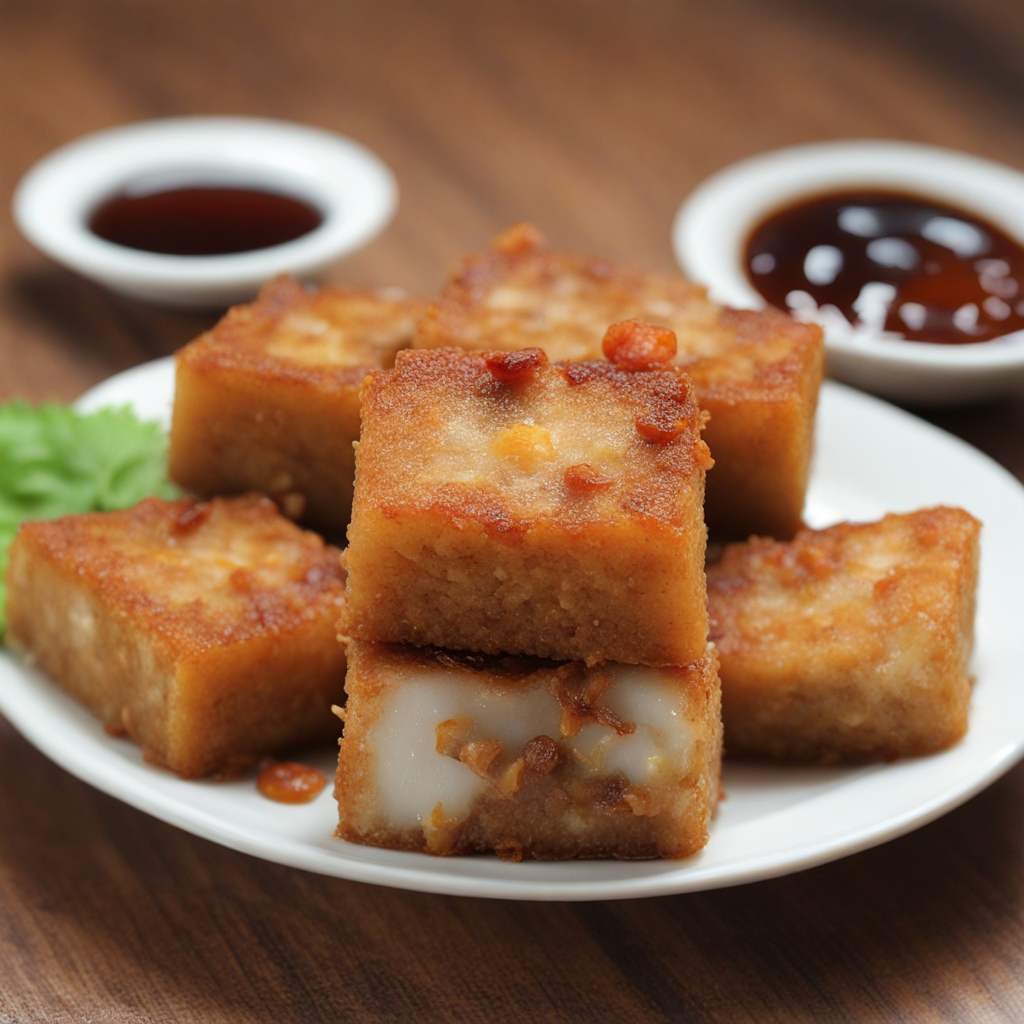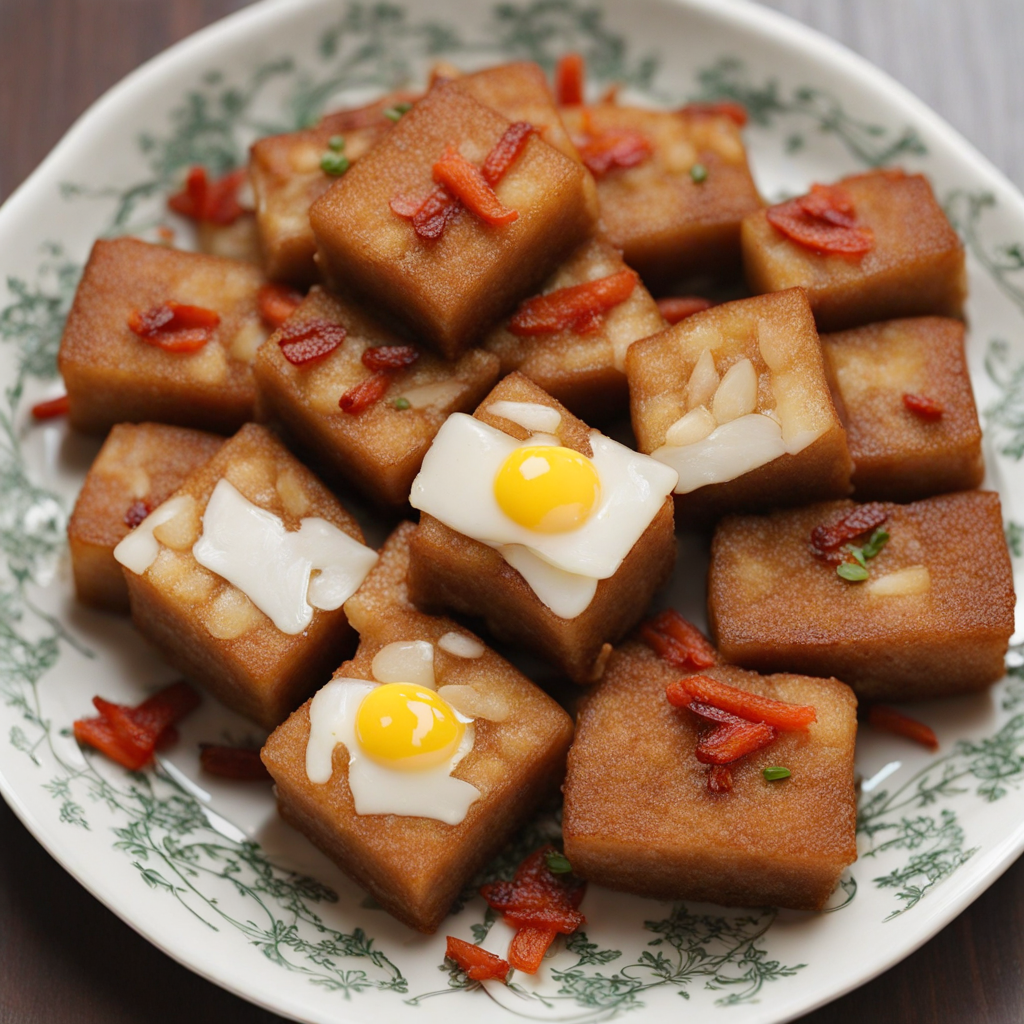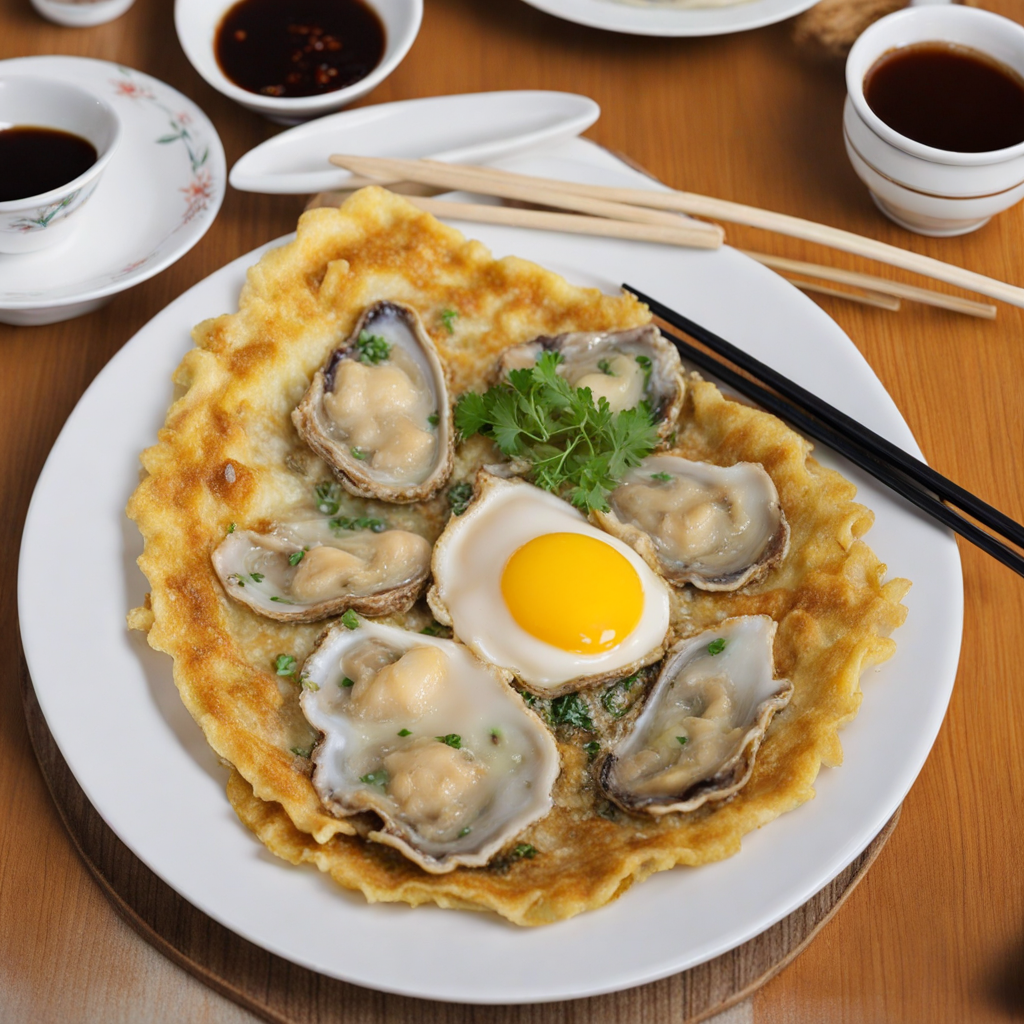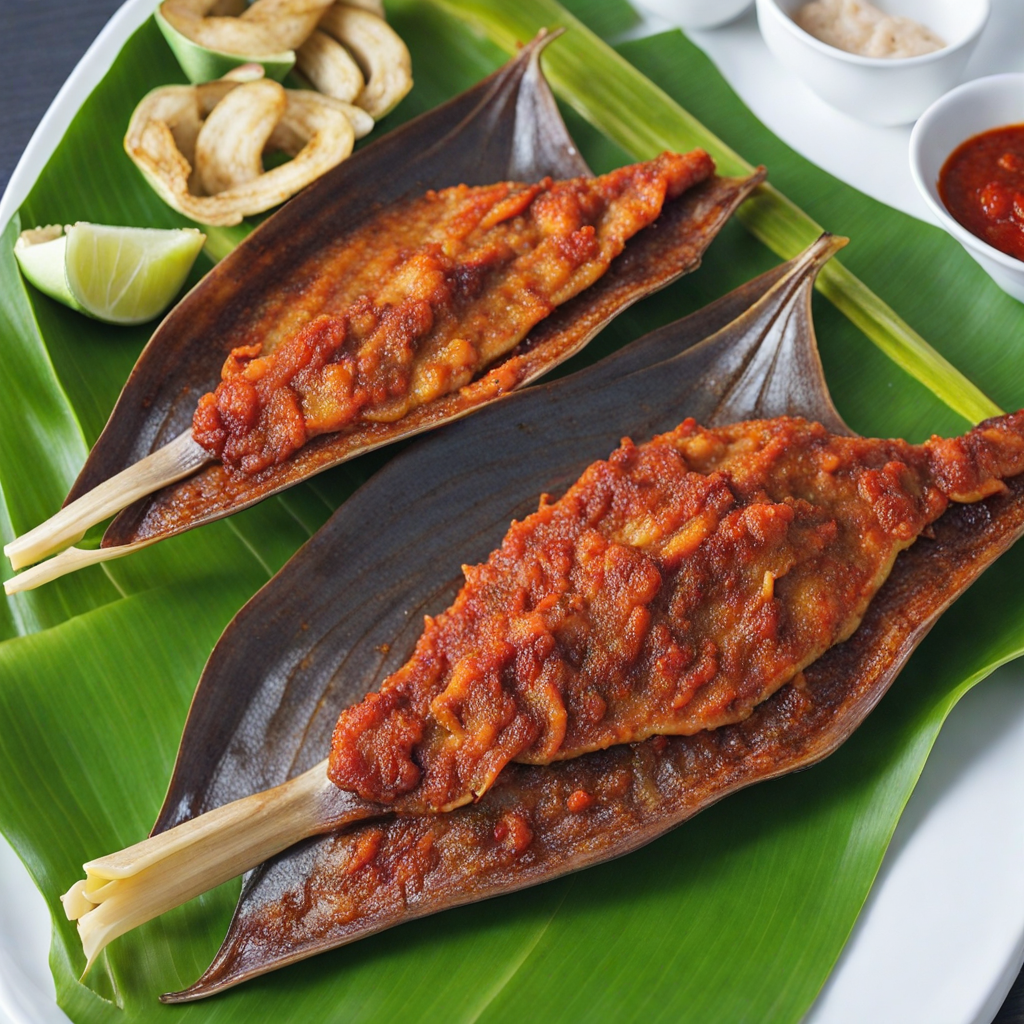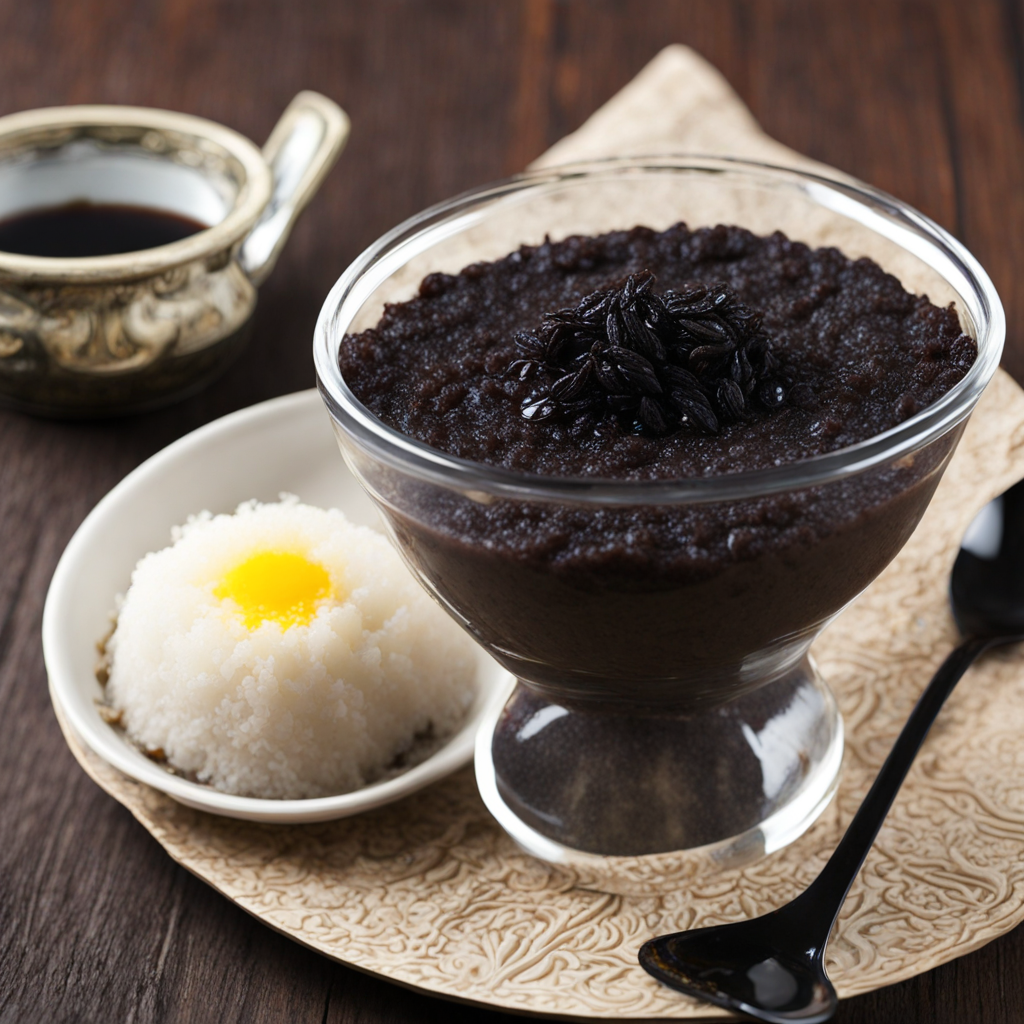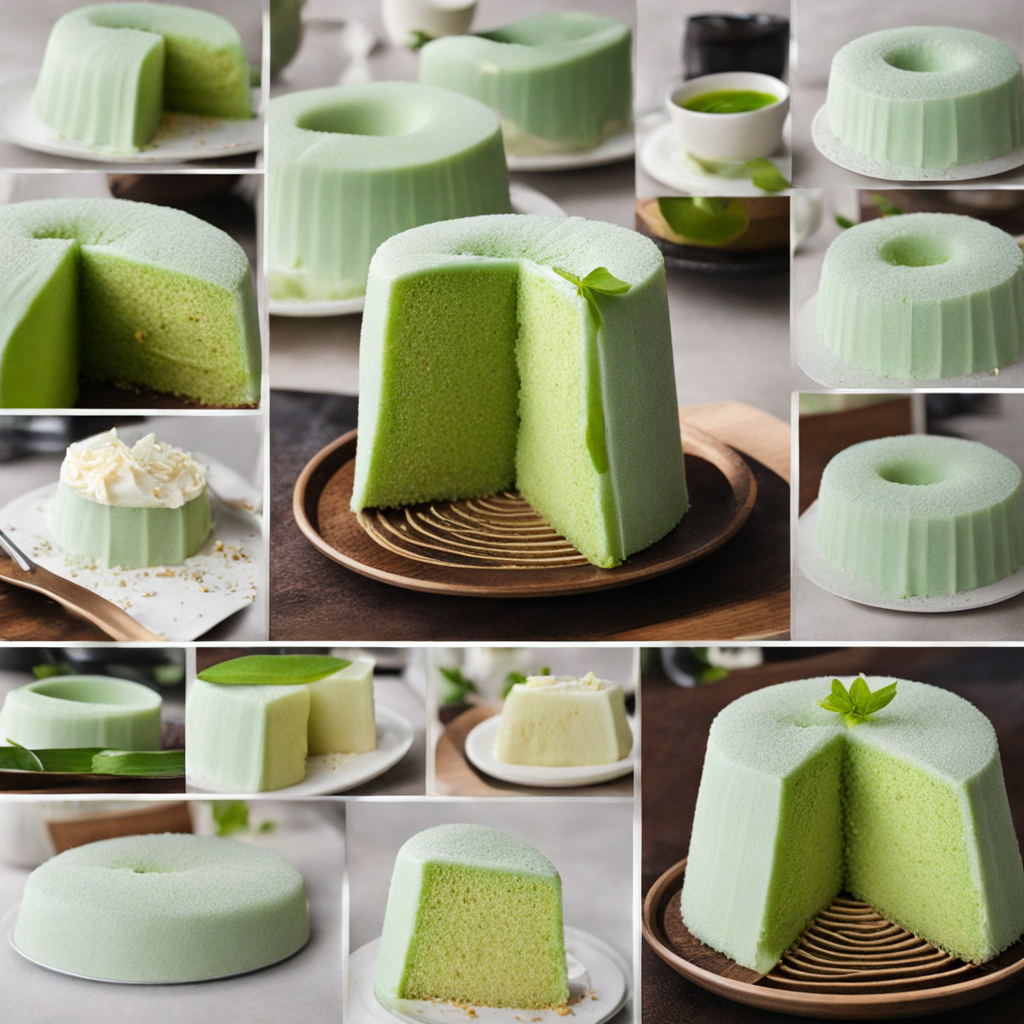Fried Carrot Cake
Fried Carrot Cake, also known as Chai Tow Kway, is a beloved dish from Singapore that showcases the unique blend of Chinese culinary traditions and local flavors. This dish is distinct from the sweet dessert you might expect from the name; instead, it features a savory cake made from rice flour and grated white radish, known as daikon. The mixture is steamed until firm, then cut into cubes and stir-fried to achieve a delightful contrast of textures—crispy on the outside while remaining soft and tender on the inside. The signature flavor comes from the addition of soy sauce, garlic, and sometimes, a hint of chili, which envelops the cake in a savory, umami-rich coating. As you take your first bite of Fried Carrot Cake, you'll experience a medley of flavors dancing on your palate. The slight sweetness from the radish balances beautifully with the salty and savory notes from the soy sauce and the earthy aroma of garlic. Depending on the vendor, you may encounter variations of the dish, such as the white version, which is simply fried with eggs and seasonings, or the black version, which incorporates sweet black soy sauce, adding a deeper, caramelized flavor. The use of fresh scallions and a sprinkling of crispy fried shallots on top provides not just an appealing visual contrast, but also an extra layer of crunch and fragrance. Fried Carrot Cake is often enjoyed as a hearty breakfast or a satisfying snack, making it a versatile addition to Singapore's vibrant street food scene. Served on a plate and typically accompanied by a side of chili sauce, this dish invites you to personalize your experience, adjusting the spice level to your liking. Whether you're a seasoned foodie or a curious newcomer, Fried Carrot Cake promises an exciting journey into the diverse world of Singaporean cuisine, leaving you craving more of its complex flavors and comforting textures.
How It Became This Dish
The History of 菜头粿 (Chai Tow Kway) in Singapore #### Origins 菜头粿, pronounced as "Chai Tow Kway," is a beloved dish that has become a staple of Singaporean street food culture. Its origins can be traced back to the Teochew and Hokkien communities in Southern China, particularly in the Fujian province. The name itself offers insight into its roots; "菜头" (Chai Tow) translates to "radish," referring to the key ingredient, while "粿" (Kway) means "cake" or "pudding," indicating its steamed or pan-fried nature. The dish is primarily made from rice flour, water, and fermented radish (菜头), which is responsible for its distinctive flavor. Traditionally, the radish is grated and mixed into the rice flour batter, giving it a savory taste that is enhanced by the frying process. The method of preparation often involves steaming the mixture to create a firm cake, which is then sliced and stir-fried with garlic, preserved soybeans, and sometimes egg, achieving a crispy exterior while maintaining a soft interior. #### Cultural Significance Chai Tow Kway is not merely a dish; it is a cultural symbol, deeply rooted in the culinary traditions of the Chinese immigrant communities in Singapore. The dish reflects the adaptability of these communities as they settled in a new land, bringing with them their culinary heritage and adapting it to local ingredients and tastes. As urbanization transformed Singapore’s landscape in the 20th century, street food became a vital part of the fabric of the city, and Chai Tow Kway found its place among the hawker stalls. In Singapore, food holds significant cultural importance, acting as a bridge that connects generations and communities. Chai Tow Kway, typically enjoyed as a breakfast or snack, resonates particularly with the older generations who remember it as a comforting food from their childhood. The dish embodies the spirit of communal dining, often enjoyed in bustling hawker centers, where families and friends gather to share food and stories. #### Development Over Time As Singapore evolved from a British colonial outpost to a multicultural metropolis, so too did its culinary landscape. The post-war period saw a significant rise in the popularity of hawker culture, with street vendors proliferating in urban areas. Chai Tow Kway became a familiar sight, as hawkers began to innovate and personalize their recipes, catering to the diverse tastes of the city’s inhabitants. In the 1960s and 70s, the dish was often prepared in its most traditional form, but hawkers started experimenting with ingredients and cooking techniques. The introduction of different types of sauces, such as chili sauce, and toppings, such as fried eggs or diced scallions, allowed for greater customization. Some hawkers began to offer a sweeter version of the dish, incorporating a touch of sugar into the mix, appealing to those with a preference for sweeter flavors. During the 1980s and 90s, as Singapore underwent rapid modernization, culinary influences from around the globe began to seep into local food culture. While traditional dishes like Chai Tow Kway remained popular, the fusion of flavors and cooking styles led to new interpretations. Some stalls began offering variations that incorporated international ingredients or techniques, reflecting the globalized nature of Singaporean cuisine. Despite these changes, the essence of Chai Tow Kway remained intact. It continued to be a dish that resonated with the nostalgia of many Singaporeans, evoking memories of childhood breakfasts shared with family. The dish became more than just food; it was a reminder of home and heritage, a comforting presence in an ever-changing urban landscape. #### Modern-Day Chai Tow Kway Today, Chai Tow Kway can be found in hawker centers across Singapore, with some stalls achieving legendary status due to their unique recipes and cooking methods. The dish has also garnered attention from food critics and enthusiasts, celebrated for its humble origins and rich flavors. Modern hawkers maintain a delicate balance between tradition and innovation, ensuring that the dish remains relevant in a fast-paced culinary scene. Food festivals and competitions have also helped elevate the profile of Chai Tow Kway, showcasing its versatility and allowing hawkers to demonstrate their skills. Some chefs have even taken the dish upscale, presenting it in fine dining restaurants with creative twists, while maintaining its core identity. In recent years, with the rise of social media, the visual appeal of Chai Tow Kway has contributed to its popularity. Beautifully plated versions of the dish, often accompanied by lush garnishes and artistic flair, are shared widely, enticing a new generation of food lovers to explore this traditional dish. #### Conclusion Chai Tow Kway is more than just a dish; it is a culinary narrative that encapsulates the history, culture, and evolution of Singaporean food. From its humble beginnings in Southern China to its status as a beloved street food in Singapore, the dish has adapted and transformed over time while retaining its core elements. Today, it stands as a testament to the resilience of cultural heritage in a rapidly changing world. As Singapore continues to navigate its multicultural identity, dishes like Chai Tow Kway remind us of the importance of food as a means of connection—between people, cultures, and histories. Whether enjoyed at a hawker center or reimagined in a modern restaurant, Chai Tow Kway remains a cherished part of Singapore's culinary landscape, reflecting the flavors and stories of its people.
You may like
Discover local flavors from Singapore


